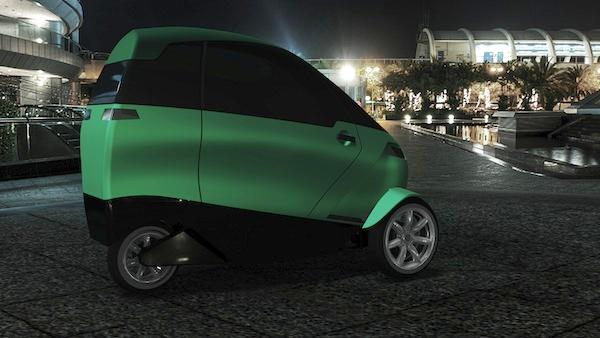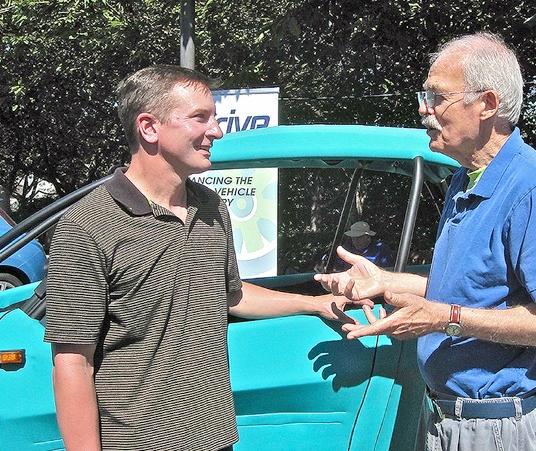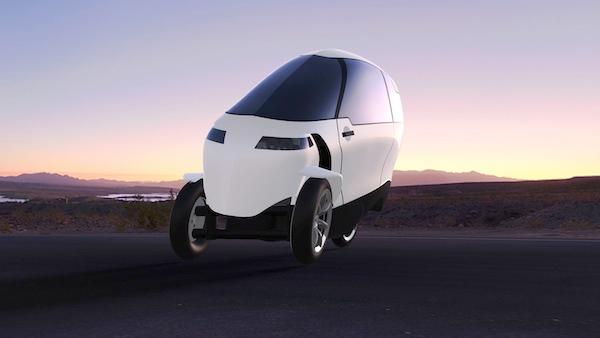Portland’s Green Machine

It's not a car. It's not a motorcycle. It's something entirely new — a green machine that combines the best features of both.
Green Lite Motors, located in one of the country's greenest cities, Portland, Ore., is a four-year-old startup in the process of creating a unique hybrid drive, two passenger, three-wheeled vehicle for use in and around large cities.
Code named GLM-1, the machine combines the comfort and safety of a well-designed car with the advantages of a motorcycle. Because it has the dimensions of a motorcycle, the vehicle provides easy parking, use of the express lane with a single occupant, and the acceleration and speed (up to 85 mph) needed for cruising the highway. Range is 250 miles with a target of 100 miles to the gallon.
It's also fun to drive. You lean smoothly into curves just like a motorcycle and when you stop, the company's Smart Stand-Up technology brings the vehicle to an upright position.
Safety is paramount: the GLM-1 passenger compartment is enclosed in a steel, race car quality safety cell, and comes equipped with four-point seat belts and air bags.
We caught up with Tim Miller, CEO of Green Lite Motors, at an outdoor Electric Vehicle Expo held August 21 in Lake Oswego, a suburb of Portland. On display was an operational third generation GLM-1 prototype, the vehicle's steel safety cage swathed in a handsome turquoise green temporary skin. Miller said he is currently seeking funding to take the project to the next stage — a fully-skinned, fully-functional version of the vehicle that is ready to go to market.

Tim Miller, CEO of Green Lite Motors (left) with John Kirkley, Editor of Digital Manufacturing Report
Making a Difference
Green Lite Motors got its start when Miller, after receiving an MBA from Stanford and working in high tech, decided "I wanted to do something that made a difference." Because he has a long time interest in transportation, he selected the hybrid drive vehicle from a variety of business concepts. He and his team found it slow going at first, working weekends and evenings to build the first physical prototypes. Their sweat equity paid off when they were named 2009 Pacific Northwest Clean Tech Open winners, earning them a spot in the national finals.
In addition to the publicity and award money resulting from their success in the Clean Tech Open, the regional competition had another major impact on the company's fortunes — it introduced them to Autodesk's digital prototyping workflow software. The Autodesk Clean Tech Partner Program supports clean technology pioneers like Miller by providing grants of up to $150,000 worth of software and licenses for only $50. Green Lite Motors applied for and was awarded the use of the Autodesk Product Design Suite.
"We were working with older generation 3D CAD software that was slow and cumbersome, but got the job done," recalls Miller. "The Autodesk software was a real shot in the arm."
The software features Autodesk Inventor, mechanical design software that allows users to create accurate digital prototypes and simulate their performance in real-life situations. It includes a parametric design environment for developing concept sketches and kinematic models of parts and assemblies. Very important to Green Lite Motors is Autodesk Inventor's ability to model the complex geometry of various components, allowing the team to rapidly design, build and test various components in virtual space before creating physical prototypes.
"At first we imported our existing models into Inventor and made design improvements," says Miller. "But then, given the flexibility and ease of use of the software, we decided to scrap the old models entirely and use the Autodesk program to build a full model of the vehicle's geometry from the ground up. Peyton McCann, our 3D modeling guru, is located in Seattle, about 300 miles north of Portland. No problem as far as working together. We get on the phone using Skype, he opens his desktop system and I'm able to log in to his computer and see his screen. We can try out new design ideas and make changes on the fly — it's been a tremendous boost to our productivity."
The unique front-end geometry of the GLM-1 allows the vehicle to lean up to about 40 degrees during turns, just like a motorcycle. It's one of the features that makes it fun to drive. But it also means that there is a dramatic movement of components during these maneuvers. In the initial model, due to the compact design of the vehicle, making a change to one front end component — such as a mounting bracket or control arm — can cause components to impinge on one another. By simulating the real-life driving maneuvers the vehicle is likely to encounter, McCann and Miller are able to redesign the parts to make sure everything works smoothly. The mechanical drawings are then exported and sent to vendors to obtain bids on the cost of manufacturing the front end assembly.
"We were able to build a new model of the front end in weeks," Miller says. "Using the older CAD system, it would have taken months."
One of the bonuses of working under the aegis of the Clean Tech Partner Program is the support provided by Autodesk. McCann is a mathematician by trade, although he has spent some time working with CAD programs. However, to bring him up to speed on its sophisticated modeling software, Autodesk provided McCann with a week long training session, as well as access to local trainers in the Seattle area and a direct line to the company's resource desk.
Miller also uses another module of the Autodesk Product Design Suite — Autodesk Showcase — to create photorealistic renderings and high quality videos for use on the Green Lite Motor's website and his presentations to potential investors and interested environmental groups and officials.

Next Steps
As they move on to the fourth generation model, the team will use additional Autodesk software to conduct finite element analysis (FEA) of the various stresses the front end will be subjected to and determine how they impact component design. Again, extensive virtual prototyping will take place before the physical parts are fabricated, saving time and money.
Autodesk Alias Design will be used to sketch, model and visualize the vehicle's external body design. The team will also employ Autodesk computational fluid dynamics (CFD) software to explore how changes in the GLM-1 external configuration will affect its drag characteristics. Says Miller, "Lowering the vehicle's drag coefficient is very important to reach our goal of 100MPG."
Green Lite Motors is now working with the Oregon Institute of Technology (OIT) to develop the hybrid's backend, a combination of hardware and software that allows a single throttle to control the car's electric and gas engines. Professors and their students at OIT are developing a control box that regulates the response of the electric motor and the gas engine to changing throttle settings.
Work on the hybrid drive system got a recent boost with the award of grants totaling $212,000 from Oregon BEST (Built Environment & Sustainable Technologies) and the Oregon Transportation Research and Education Consortium.
Next Miller plans to raise $1,000,000 in capital funding to produce a full-featured production model that can go to market.
"Five, ten, or twenty years ago, an automotive project like ours was totally out of reach for a small company," notes Miller. "The cost and complexity of the required design resources could only be handled by the big manufacturers. But now, with software like the Autodesk Product Design Suite, small businesses such as Green Lite Motors can design and prototype a product quickly and efficiently. This is a whole new way of working that opens up opportunities undreamed of in the past."










